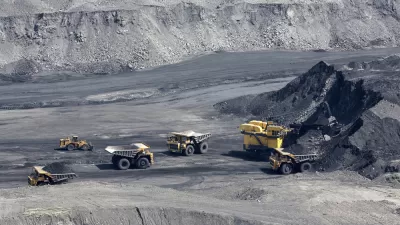Things have gone terribly wrong at Mississippi's Kemper County energy facility, a federally supported, $6.7 billion carbon capture and storage coal power plant that is now two years behind schedule and $4 billion over budget.
Carbon capture and storage (CCS) technology, sometimes referred to as 'clean coal,' is an integral part of President Obama's clean power plan, enabling coal power plants to reduce up to 90 percent of their carbon emissions.
"As the emphasis on fighting climate change grew, the Obama administration hung many of its hopes on Kemper," reports Ian Urbina, investigative correspondent for The New York Times. "Gina McCarthy, the Environmental Protection Agency administrator, cited federal support for the project as proof that her agency was not anti-coal, despite strict new rules on power-plant emissions."
E.P.A. regulations in effect require new coal plants to have carbon capture technology but are being held up in federal court partly by arguments that the technology is not cost-effective.
The importance of this technology grows, as well, after President Obama said last week that the United States would join Canada and Mexico in pledging to reach a shared goal of generating 50 percent of North America’s electricity from zero-carbon sources by 2025, up from 37 percent today, with a power mix that includes wind, solar, hydropower, nuclear energy and coal or gas power paired with carbon capture technology.
With coal and natural gas each supplying a third of U.S. power last year, but coal producing 71 percent of carbon emissions from electric power, and coal producing 39 percent of global CO₂ emissions, many view CCS as essential to reducing carbon emissions.
Kemper County Energy Facility was "supposed to be a model for future power plants to help slow the dangerous effects of global warming," writes Urbina. "The project was hailed as a way to bring thousands of jobs to Mississippi, the nation’s poorest state, and to extend a lifeline to the dying coal industry."
In a very comprehensive piece, Urbina describes the questionable issues surrounding the plant, from before it broke ground in 2010, to the rate increases that "shifted the burden of one of the most expensive power plants ever built onto the shoulders of unwitting investors and some of the lowest-income ratepayers in the country...The power plant and its owner, Southern Company, are the focus of a U.S. Securities and Exchange Commission investigation."
[A] review by The New York Times of thousands of pages of public records, previously undisclosed internal documents and emails, and 200 hours of secretly though legally recorded conversations among more than a dozen colleagues at the plant offers a detailed look at what went wrong and why.
In the end, the Kemper project is a story of how a monopoly utility, with political help from the Mississippi governor and from federal energy officials who pressured state regulators in letters to support the project, shifted the burden of one of the most expensive power plants ever built onto the shoulders of unwitting investors and some of the lowest-income ratepayers in the country.
However, even if there was no mismanagement, questions remain on the viability of these plants, particularly when carbon emissions aren't priced (either by a carbon tax or carbon market). Kemper's carbon will be used for enhanced oil recovery, an oil drilling technology, in the Denbury Oil Field.
To read, listen and/or watch accounts of Urbina's investigation, see his interviews on National Public Radio and the PBS NewsHour.
Correspondent's addendum: Kempler should not be viewed as emblematic of CCS facilities. A better example may be the Petra Nova project, 27 miles from Houston, described in 2014 as the "world's largest carbon capture and storage facility" and expected to be operational later this year.
A major difference between Kemper and Petra Nova is that the latter is converting an existing coal-powered plant while the former is building a new plant. They also utilize different carbon capture and storage technologies: Kemper uses an integrated gasification combined cycle (IGCC) process while Petra Nova uses a post-combustion CO2 control system.
Two prior posts are critical of the CCS technology:
- EPA Power Plant Rule Hinges on Unproven Technology," (September 2013,
- Carbon Capture A Ploy? (March 2009, The Economist via Minneapolis Star-Tribune)
FULL STORY: Piles of Dirty Secrets Behind a Model ‘Clean Coal’ Project

Planetizen Federal Action Tracker
A weekly monitor of how Trump’s orders and actions are impacting planners and planning in America.

Map: Where Senate Republicans Want to Sell Your Public Lands
For public land advocates, the Senate Republicans’ proposal to sell millions of acres of public land in the West is “the biggest fight of their careers.”

Restaurant Patios Were a Pandemic Win — Why Were They so Hard to Keep?
Social distancing requirements and changes in travel patterns prompted cities to pilot new uses for street and sidewalk space. Then it got complicated.

Platform Pilsner: Vancouver Transit Agency Releases... a Beer?
TransLink will receive a portion of every sale of the four-pack.

Toronto Weighs Cheaper Transit, Parking Hikes for Major Events
Special event rates would take effect during large festivals, sports games and concerts to ‘discourage driving, manage congestion and free up space for transit.”

Berlin to Consider Car-Free Zone Larger Than Manhattan
The area bound by the 22-mile Ringbahn would still allow 12 uses of a private automobile per year per person, and several other exemptions.
Urban Design for Planners 1: Software Tools
This six-course series explores essential urban design concepts using open source software and equips planners with the tools they need to participate fully in the urban design process.
Planning for Universal Design
Learn the tools for implementing Universal Design in planning regulations.
Heyer Gruel & Associates PA
JM Goldson LLC
Custer County Colorado
City of Camden Redevelopment Agency
City of Astoria
Transportation Research & Education Center (TREC) at Portland State University
Camden Redevelopment Agency
City of Claremont
Municipality of Princeton (NJ)



























